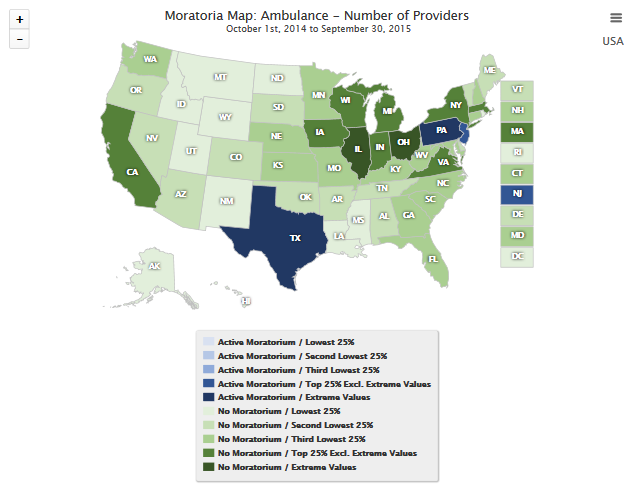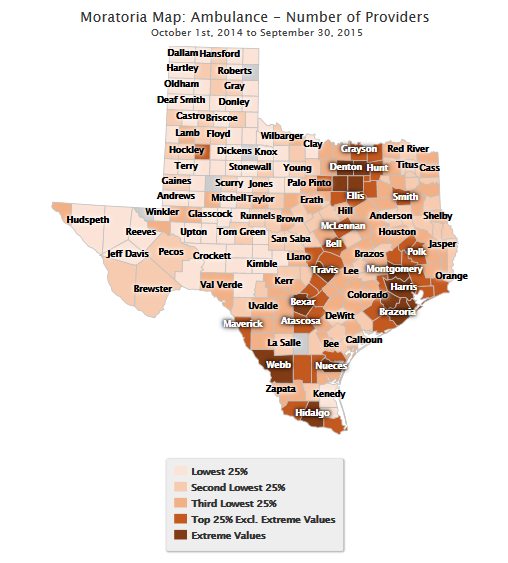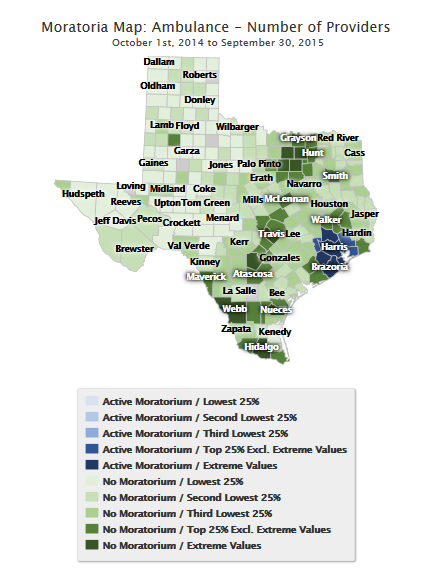Moratoria Provider and Supplier Services and Utilization Data Tool
(Updated on June 22, 2016)Â
The Centers for Medicare & Medicaid Services (CMS) has developed a Moratoria Provider and Supplier Services and Utilization Data Tool that includes interactive maps and a dataset that shows national-, state-, and county-level provider and supplier services and utilization data for selected health service areas. For this first release, the data provide information on the number of Medicare ambulance suppliers and home health providers servicing a geographic region, with moratoria regions at the state and county level clearly indicated, and the number of Medicare beneficiaries who use one of these services. The data can also be used to reveal the degree to which use of these services is related to the number of providers and suppliers servicing a geographic region. Provider and supplier services and utilization data by geographic regions are easily compared using the interactive maps.
The tool is available through the CMS website at: https://data.cms.gov/moratoria-data. Â All information presented graphically in the data maps is available for download. Future releases may include comparable information on additional health service areas.
Methodology
The analysis is based on paid Medicare claims data from the CMS Integrated Data Repository (IDR). The IDR contains Medicare & Medicaid claims, beneficiary data, provider data, and plan data. Claims data are analyzed for a 12-month reference period, and results are updated quarterly to reflect a more recent 12-month reference period.
The Moratoria Provider and Supplier Services and Utilization methodology is different from other public use data with respect to determining the geographic location of a provider or supplier. In this analysis, claims are used to define the geographic area(s) served by a provider or supplier rather than the providerâs or supplierâs practice address. Further, a provider or supplier is defined as âserving a countyâ if, during the 12-month reference period, the provider or supplier had paid claims for more than ten beneficiaries located in a county. A provider or supplier is defined as âserving a stateâ if that provider or supplier serves any county in the state.
The Moratoria Provider Services and Utilization methodology is also different from other public use data with respect to determining the number of Medicare beneficiaries who are enrolled in a fee-for-service (FFS) program. In this analysis, a FFS beneficiary is defined as being enrolled in both Part A and Part B with FFS coverage for at least one month of the 12-month reference period. There must not be a death date for that month or a missing ZIP Code for the beneficiary so that the beneficiary can be assigned to a county. Other public use data may define a FFS beneficiary using different criteria, such as requiring the beneficiary to be enrolled in the FFS program every month during the reference period.
The interactive map is color-coded based on an analysis that separates the distribution into the following categories of states/counties for the selected metric: lowest 25 percent, second lowest 25 percent, third lowest 25 percent, top 25 percent excluding extreme values. Â An extreme value is one that greatly differs from other values in its field (e.g., Number of Providers and Suppliers). Â Moratoria vs. non-moratoria states/counties are also identified based on color scheme. Counties that are excluded from the analysis are colored gray in the interactive map. The examples below utilize the Ambulance Service Area data; similar maps can be created through the Data Tool for the Home Health Service Area.
Map 1 displays the distribution of suppliers per Ambulance Service Area by state for the October 1, 2014 through September 30, 2015 timeframe. This map utilizes a single color scale, which does not distinguish between moratoria and non-moratoria states.
Map 1. National Distribution of Number of Providers for Ambulance per Service Area
October 1, 2014 â September 30, 2015
Single Color Scale
Map 2 displays the distribution of providers per Ambulance Service Area by state for the October 1, 2014 through September 30, 2015 timeframe. This map utilizes a dual color scale, which distinguishes between moratoria and non-moratoria states.
Map 2. National Distribution of Number of Providers for Ambulance per Service Area
October 1, 2014 â September 30, 2015
Dual Color Scale
Map 3 drills down to the county level and displays the distribution of providers per Ambulance Service Area by county within the State of Texas for the October 1, 2014 through September 30, 2015 time frame. This map utilizes a single color scale, which does not distinguish between moratoria and non-moratoria counties.
Map 3. County Distribution of Number of Providers for Ambulance per Service Area
October 1, 2014 â September 30, 2015
Single Color Scale
Map 4 drills down to the county level and displays the distribution of providers per Ambulance Service Area by county within the State of Texas for the October 1, 2014 through September 30, 2015 time frame. This map utilizes a dual color scale, which distinguishes between moratoria and non-moratoria counties.
Map 4. County Distribution of Number of Providers for Ambulance per Service Area
October 1, 2014 â September 30, 2015
Dual Color Scale
Similar maps can be created at the national- and state-level for the following metrics: Number of FFS Beneficiaries, Average Number of Users per Provider, Percentage of Users out of FFS Beneficiaries, and Average Number of Providers per County.
###



